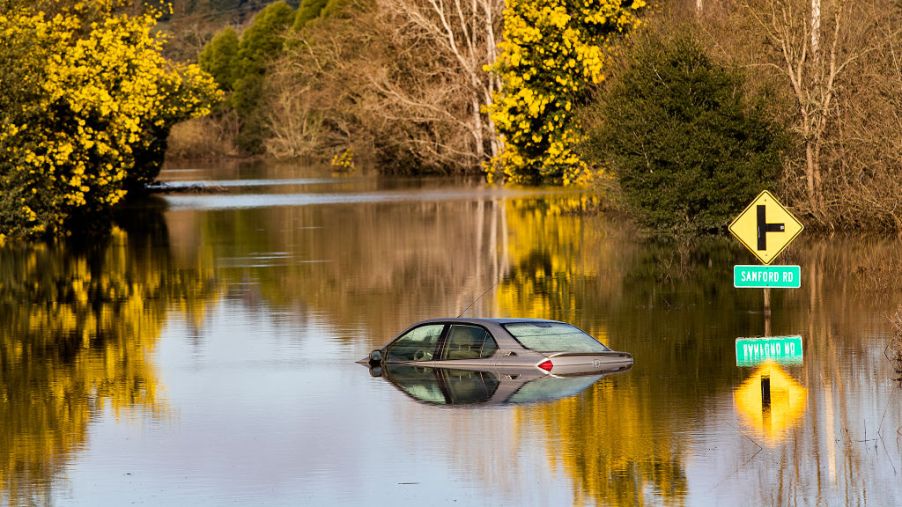
Is a Car Considered Totaled After a Flood?
With powerful weather events like hurricanes, more and more vehicle owners face a difficult situation. If their vehicles were swamped due to flooding, they have to figure out if their vehicle is totaled. On top of that, according to Consumer Reports, car owners are likely to run into even bigger problems if they don’t have comprehensive insurance on a vehicle that has been through a flood.
Is a car totaled after a flood?
If you’re really fond of your car, prepare for the worst-case scenario if it’s been in a flood. It may be too costly to repair.
The chief mechanic for Consumer Reports, John Ibbotson, explained that when water gets into a vehicle’s intake, it creates many problems. Typically, the intake is at the front of the car to channel in fresh air while the vehicle is in motion. Water that enters the car through the intake can cause the engine to stall. It can also render the engine unable to start.
Many newer vehicles also have a lot of technology features. When those components get wet, electrical problems often follow. There’s a high chance those features may immediately fail from the water exposure.
Repairs for flooded vehicles are usually very costly. You’re looking at fixing or replacing the engine along with any electrical or electronic components. Add to that damage to the interior like mold, corrosion, and wet upholstery and flooring.
State Farm Insurance spokesperson Rachael Rissinger told Consumer reports that individual states have guidelines outlining when a vehicle is considered totaled. It usually involves comparing a car’s value with the estimated cost of repairs.
She explained that if it’s determined that the vehicle is a total loss, the insurance company will work with the vehicle owner. If they have comprehensive coverage, the insurance company will issue a payment for the vehicle and its title minus the deductible.
What is the best auto insurance coverage for flood prone areas?
When it comes to acquiring auto insurance, many don’t understand exactly what they are getting. As much as 68% of Americans mistakenly believe that any damage to their car is covered by the comprehensive part of their policy.
Here’s what those common insurance terms actually means:
- Collision: If your vehicle sustains damage due to a collision with another vehicle or an object like a guardrail or tree and the accident is your fault, collision coverage reimburses you for the damage.
- Comprehensive: If your vehicle’s broken into or damaged in an incident that wasn’t a collision, the coverage reimburses you for the damage. This includes hitting animals, falling rocks or trees, fire, flood, and vandalism.
All vehicle owners should consider comprehensive coverage according to Consumer Reports regardless of the age of their car. If a weather event sees your vehicle swamped or stolen, comprehensive coverage protects you.
Know what to expect after you car has been through a flood
If your vehicle flooded in a large weather event, keep in mind that the same thing just happened to thousands of other people. Be patient when trying to get your vehicle assessed for either repair or replacement. The insurance company’s process as they try to work with clients during a natural disaster can take a couple of weeks.
Rissinger explained that it usually doesn’t take long for insurance agents to inspect a swamped car to determine if it’s totaled or salvageable.
If the same natural disaster displaces you, call your insurance company. The claims department of most companies is familiar with such situations. They will be able to assist you as in recovering from the weather event.
If you don’t know where your vehicle is, don’t put yourself in danger trying to find it. When you talk to your insurance company, give the agent your vehicle’s last known location. They’ll be able to lead you through the next actions to take. The insurer can send a tow truck to fetch a vehicle that’s submerged as it might not be safe to drive if it starts at all.
If you can’t find your car, contact your local policy along with any agencies working clean up after the incident. There’s a chance they already had the vehicle towed to a storage area. If so, they’ll be able to tell you where to find it. Thanks to today’s technology, drones are useful in finding vehicles lost in storms and help speed up the process.
Assessing your storm-damaged car
When taking a closer look at your vehicle after a flood, there are a few precautions to keep in mind. You’ll want to take notes on the damage you can see to your vehicle and how high the water appears to have risen in your car.
It’s not a good idea to try and start the car. It could do even more damage if there’s water in the engine. Just work on drying out the car as soon as you can. If your car is not in a safe place, call a towing service to help you move it to higher ground. Be sure to make note if saltwater flooded the vehicle, because seawater can be highly erosive.


